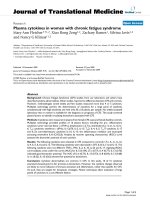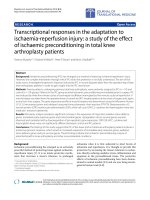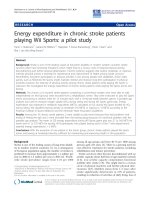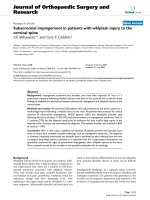báo cáo hóa học:" Septic arthritis in patients with rheumatoid arthritis Abdulaziz Al-Ahaideb" doc
Bạn đang xem bản rút gọn của tài liệu. Xem và tải ngay bản đầy đủ của tài liệu tại đây (203.62 KB, 3 trang )
BioMed Central
Page 1 of 3
(page number not for citation purposes)
Journal of Orthopaedic Surgery and
Research
Open Access
Review
Septic arthritis in patients with rheumatoid arthritis
Abdulaziz Al-Ahaideb
Address: College of medicine, King Saud University, Riyadh, Saudi Arabia
Email: Abdulaziz Al-Ahaideb -
Abstract
There is an increasing number of rheumatoid patients who get septic arthritis. Chronic use of
steroids is one of the important predisposing factors. The clinical picture of septic arthritis is
different in immunocompromised patients like patients with rheumatoid arthritis. The diagnosis and
management are discussed in this review article.
Introduction
The association of septic arthritis in patients with rheuma-
toid arthritis has been recognized for over fifty years [1].
Since that time there have been over 400 reported cases in
the literature [2,3] but to date no mechanism for this
increased susceptibility has been confirmed. Diagnosis of
septic arthritis in the rheumatoid patient is often delayed
with a notably worse outcome when compared to other
patients with septic arthritis [4]. Little has been published
on the topic of septic arthritis in patients with rheumatoid
arthritis. Work by Goldenberg [5] in 1989 and Gardner
and Weisman [6] in 1990 where they presented their case
experience and reviewed the literature, is still considered
the standard when discussing this topic.
Discussion
Pathogenesis
Any chronically arthritic joint is predisposed to infection
[5]. The mechanisms responsible for this have yet to be
precisely identified but previously published data [3,5]
have highlighted some of the possible contributing fac-
tors. It has been hypothesized that in the rheumatoid
patient that phagocytosis by the polymorphonuclear
(PMN) cells in the blood and synovial fluid is defective
[7,8] leading to the increased susceptibility to infection.
Turner et al. [7] thought that this was likely due to
increased ingestion of immune complexes by the PMN's
in the synovial fluid leading to impaired uptake. While
Wilton et al. [8] postulated that this decreased ability to
ingest and kill bacteria could be due to deficiency in the
expression of C'3 on the PMN in the synovial fluid. How-
ever, more recently, Breeveld et al [9] failed to observe any
defect in phagocytosis by the PMN's. Their work demon-
strated that both uptake and intracellular killing of Staphy-
lococcus aureus was intact in the synovial fluid and
peripheral blood.
Abnormal joint structure and pre-existing joint lesions
have also been implicated in the increase susceptibility of
the rheumatoid patient to septic arthritis. It is thought that
anomalous joint structure present in rheumatoid patients
could allow microorganisms to escape normal phagocyto-
sis [5]. Mahowald et al. [10], using the Dumonde Glynn
model of antigen induced arthritis in rabbits followed by
introduction of S. aureus, hypothesized that infection in
the arthritic joint extends along the pannus to the
subchondral bone. There is extensive neovascularization
in the subsynovium in an arthritic joint. She postulated
that the vascualrization subsequently becomes occluded
with bacteria leading to the ischemic changes of the
subchondral bone and subsynovium [5,10]. All of these
factors combine to cause the more rapid histological
changes observed in the arthritic joint when infected. It is
also thought possible that microorganisms could traffic
Published: 29 July 2008
Journal of Orthopaedic Surgery and Research 2008, 3:33 doi:10.1186/1749-799X-3-33
Received: 12 January 2008
Accepted: 29 July 2008
This article is available from: />© 2008 Al-Ahaideb; licensee BioMed Central Ltd.
This is an Open Access article distributed under the terms of the Creative Commons Attribution License ( />),
which permits unrestricted use, distribution, and reproduction in any medium, provided the original work is properly cited.
Journal of Orthopaedic Surgery and Research 2008, 3:33 />Page 2 of 3
(page number not for citation purposes)
from skin lesions to draining lymph nodes through the
inflamed synovium [3] or that infection could track to the
joint from an adjacent focus of osteomyelitis [11].
It is known that there is a higher incidence of infection in
those individuals ingesting exogenous steroids [5],
although 50% of patients with rheumatoid arthritis who
developed polyarticular septic arthritis (PASA) were not
receiving steroids [3]. It is therefore thought that there is
also a general reduction in resistance to infection in the
rheumatoid patient. This leads to a higher incidence of
systemic complications in this patient population [12]. In
fact, Vandenbroucke et al. [13] observed that bronchitis
and pneumonitis were more severe in the rheumatoid
patient when compared to a patient with osteoarthritis. It
was however noted that there was no difference in the fre-
quency of infection between these two populations and
there was also little difference in the type of infection
present [14].
Ostensson and Genborek [15] also stressed the important
role of previous intra-articular injections even in the
development of septic arthritis months following injec-
tion. There have been some reports of isolated glucocorti-
coid injection resulting in infection [16,17] but the rate
observed by this group was uniquely elevated [16].
Tumor necrosis factor alpha (TNF-alpha) plays an impor-
tant role in the host defense against infection. Inhibition
of its activity could therefore be anticipated to augment
the risk of infection. A marked increase in opportunistic
infections, particularly tuberculosis, has been described
with etanercept, an agent that blocks TNF-alpha activity
[18,19].
Clinical Features
Typically a patient with septic arthritis presents with acute
onset of severe joint pain, exacerbated with minimal
movement, accompanied by swelling and erythema at the
effected joint. There are also systemic manifestations of
infection including fever, elevated white blood cell (WBC)
count and increased erythrocyte sedimentation rate (ESR).
However this is not always the case in rheumatoid
patients who present with polyarticular septic arthritis
(PASA). Often the onset is more insidious and is mistaken
for a flare of rheumatoid arthritis.
Data compiled by Dubost et al [3] demonstrated that the
average age of rheumatoid patients who developed PASA
was 62 years of age and the risk of developing PASA is
twice as high in males [3]. The patient's rheumatoid
arthritis was most often present for more than 10 years
and the patients had advanced erosive, seropositive rheu-
matoid arthritis [16]. Twenty percent of patients were afe-
brile on presentation and only 63% of patients with PASA
developed a temperature above 38°C. Infection involved
a mean of 3.5 joints with the knee being most common
followed by elbow, wrist ankle, hip and shoulder [6].
Infections in the metatarsalphalangeal, sternoclavicular,
and metacarpophalangeal joints have also been reported
[6]. Individuals with hip and knee prosthesis are also at
increased risk for developing septic arthritis [17].
Lab tests in these patients revealed that leukocytosis was
present in 60–63% of published cases of patients with
PASA. The ESR was on the average 90 mm/hr with no dif-
ference observed when comparing rheumatoid with non-
rheumatoid groups. A value of >100 mm/hr was present
in 49% of those with PASA [3,20,21]. Joint aspirate of syn-
ovial fluid revealed an average of 120 000 leukocytes/
mm
3
. It is important to note that pyathrosis in these
patients often leads to a flare of rheumatic arthritis and
the individuals may have other joints where "sterile" syn-
ovial fluid is present [3]. Blood cultures were positive in
77–86% of cases published [3].
Because of the previous history of rheumatoid arthritis,
the insidious onset of the symptoms and the presence of
some "sterile" joints, there is often a delay in the diagnosis
of the septic arthritis in these patients. In fact Blackburn et
al [22] reported an average delay in diagnosis of 13.7 days
and the diagnosis was often made serendipitously during
an arthrogram or an intra-articular injection [5]. Micro-
scopic analysis and culture of synovial fluid are funda-
mental diagnostic tools in the evaluation of possible joint
sepsis. Sonographic guidance of arthrocentesis led to suc-
cessful aspiration of difficult-to-access joints as shoulder
and hip [23]. MR imaging is a very useful tool in diagnos-
ing septic arthritis. The inherent tissue contrast provided
by MR imaging allows for the delineation of soft-tissue
infection and osteomyelitis [24].
Bacteriology and Source of Infection
Literature reports involving patients with PASA and rheu-
matoid arthritis reveals that as many as 93% of the infec-
tions were caused by S. aureus. Other species of
microorganism are poorly reported in the literature but
cases of PASA caused by Streptococcus pneumoniae, Groups
B, C and G Strep, Hemophilus and Gram-negative bacilli
have also been reported [3,6].
The most common source of the septic arthritis was the
skin. These accounted for 76% of the cases where a source
of infection could be identified [6]. Often these were rheu-
matoid nodules or ulcerated calluses of the rheumatoid
foot [3,6]. Other identified sources of infection include
urinary tract, lung, and GI tract [6].
Journal of Orthopaedic Surgery and Research 2008, 3:33 />Page 3 of 3
(page number not for citation purposes)
Management and Outcome
Once the diagnosis of septic arthritis is suspected, joint
aspirate should be performed with initial choice of antibi-
otic based on Gram stain [5,16]. Gram positive cocci can
be treated with vancomycin or a third generation cepha-
losporin while Gram negative bacilli are best treated with
a third generation cephalosporin in addition to an
aminoglycoside [5]. If the Gram stain comes back nega-
tive broad-spectrum therapy should be initiated [16].
There is little published data with respect to the optimal
method of drainage of the infected joint. There are no pro-
spective studies comparing surgical drainage and repeated
needle aspiration and each case must be dealt with on an
individual basis [5]. It is thought that surgical drainage
may provide the patient with increased joint protection
and is often the preferred mode of treatment in the patient
with rheumatoid arthritis due to their increased suscepti-
bility to joint damage. It is thought that this more aggres-
sive approach may reduce recurrence and lower mortality
[6]. Arthroscopy, however, has shown promise in some
instances of pyarthrosis [25].
Mortality in rheumatic patients with PASA is as high as
50% [3,5,6]. This is significant especially when compared
to rheumatic arthritis patients with monoarticular pyar-
throsis whose death rate is 15%. Morbidity is also greatly
affected in these patients. Goldenberg [5] reported that
joint outcome is poor in rheumatoid arthritis patients
compared to non-rheumatoid patients. In addition
patients with rheumatoid arthritis are more likely to have
a recurrence of disease when compared to those without
rheumatoid arthritis [6]. It is also important to note that
patients who had their treatment initiated within 7 days
had the best chance at a positive outcome [6].
Conclusion
The association of septic arthritis in the patient with rheu-
matoid arthritis has been recognized for several decades
but in most cases it is a condition which is difficult to
identify, often requiring a high degree of clinical suspi-
cion. It is very crucial to reach the diagnosis of septic
arthritis in an early stage in any case but in particular, in
immuno-compromised patients like the rheumatoid
patients. Late diagnosis may lead to disastrous sequale.
Competing interests
The author declares that they have no competing interests.
References
1. Kellgren JH, Ball J, Fairbrother RW, Barnes KL: Suppurative arthri-
tis complicating rheumatoid arthritis. Br Med J 1958,
1:1193-1199.
2. Epstein JH, Zimmerman B, Ho G: Polyarticular septic arthritis. J
rheumatol 1986, 13:1105-1107.
3. Dubost JJ, Fis I, Lopitaux R, Soubrier M, Ristori JM, Bussiere JL, Sirot
J, sauvezie : Polyarticular Septic Arthritis. Medicin 1993,
72:296-310.
4. Goldenberg DL, Red JI: Bacterial Arthritis. N Engl J Med 1985,
312:764-771.
5. Goldenberg DL: Infectious arthritis complicating rheumatoid
arthritis and other chronic rheumatic disorders. Arthritis
Rheum 1989, 32(4):496-502.
6. Gardner GC, Weisman MH: Pyarthrosis in patients with rheu-
matoid arthritis: A report of 13 cases and a review on the lit-
erature from the past 40 years. Am J Med 1990, 88:503-511.
7. Turner RA, Schumacher HR, Myers AR: Phagocytic function of
polymorphonuclear leukocytes in rheumatic disease. J Clin
Invest 1973, 52:1632-1635.
8. Wilton JMA, Gibson T, Chuck CM: Defective phagocytosis by
synovial fluid and blood polymorphonuclear leukocytes in
patients with rheumatoid arthritis. Rheumatol Rehabil 1978,
17(suppl):25-35.
9. Breedveld FC, LaFeber GJM, Barselaar MT van den, van Dissel JT,
Leijh PCJ: Phagocytosis and intracellular killing of Staphyloco-
ccus aureus by polymorophonuclear cells from synovial fluid
of patients with rheumatoid arthritis. Arthrits Rheum 1986,
29:166-173.
10. Mohowald ML: Animal models of infectious arthritis. Clin
Rheum Dis 1986, 12:403-421.
11. Atcheson SG, Ward JR: Acute hematogenous osteomyelitis
progressing to septic synovitis and eventual pyarthrosis: the
vascular pathway. Arthritis Rheum 1978, 21:968-971.
12. Baum J:
Infection and rheumatoid arthritis. Arthritis Rheum 1971,
14:135-137.
13. Vanderbroucke JP, Kaaks R, Valkenburg HA, Boersma JW, Cats A,
Festen JJM, Hartman AP, Huber-Bruning O, Rasker JJ, Weber J: Fre-
quency of infections among rheumatoid arthritis patients,
before and after disease onset. Arthritis Rheum 1987, 30:810-813.
14. Van Albada-Kuipers GA, Linthorst J, Peeters EAJ, Breeveld FC, Dijk-
mans BAC, Hermans J, vandenbroucke JP, Cats A: Frequency of
infection among patients with rheumatoid arthritis versus
patients with osteoarthritis or soft tissue rheumatism. Arthri-
tis Rheum 1988, 31:667-671.
15. Ostensson A, Geborek P: Septic arthritis as a non-surgical com-
plication in rheumatoid arthritis: Relation to disease severity
and therapy. Br J Rheumatol 1991, 30:35-38.
16. Nolla JM, Gomez-Vaquero C, Fiter J, Mateo L, Juanola X, Rodriguez-
Moreno J: Pyarthrosis in patients with rheumatoid arthritis: A
detailed analysis of 10 cases and literature review. Semin
Arthritis Rheum 2000, 30(2):121-126.
17. Kaandorp CJE, van Schaardenburg D, Krijnen P, Habbema JDF, Laar
MAFJ ven de: Risk factor for septic arthritis in patients with
joint disease. Arthritis Rheum 1995, 38:1819-1825.
18. Cunnane G, Doran M, Bresnihan B: Infection and biological ther-
apy in rheumatoid arthritis. Best Pract Res Clin Rheumatol 2003,
17:345-363.
19. Mor A, Mitnick HJ, Greene JB, Azar N, Budnah R, Fetto J: Relapsing
oligoarticular septic arthritis during etanercept treatment
of rheumatoid arthritis. J Clin Rheumatol 2006, 12(2):87-9.
20. Kaandorp CJE, van Schaardenburg D, Krijnen P, Habbema JDF, Laar
MAFJ ven de: Risk factor for septic arthritisin patients with
joint disease. Arthritis Rheum 1995, 38:1819-1825.
21. Travers V, Norotte G, Roger B, Apoil A: Traitement des arthrites
aigues a pyogenes des grosses articulations des membres. A
propos de 79 cas. Rev Rhum 1988,
55:655-660.
22. Blackburn WD Jr, Dunn TL, Alarcon GS: Infection versus disease
activity in rheumatoid arthritis: eight years' experience.
South Med J 1986, 79:1238-1241.
23. Schiavon F, Favero M, Carraro V, Riato L: Septic arthritis: what is
the role for the rheumatologist? Reumatismo 2008, 60(1):1-5.
24. Bancroft LW: MR imaging of infectious processes of the knee.
Radiol Clin North Am 2007, 45(6):931-41.
25. Parisien JS, Shaffer B: Arthroscopic management of pyarthrosis.
Clin Orthop Relat Res 1992, 275:243-247.









